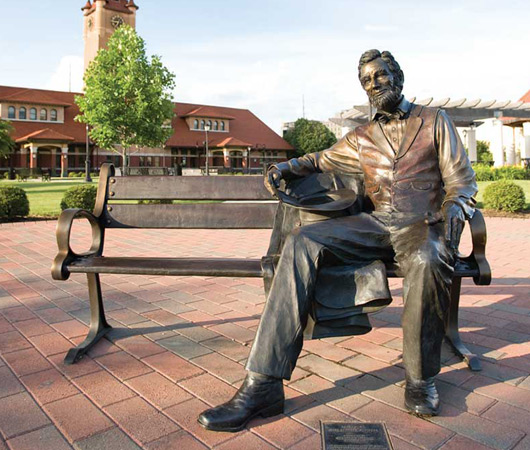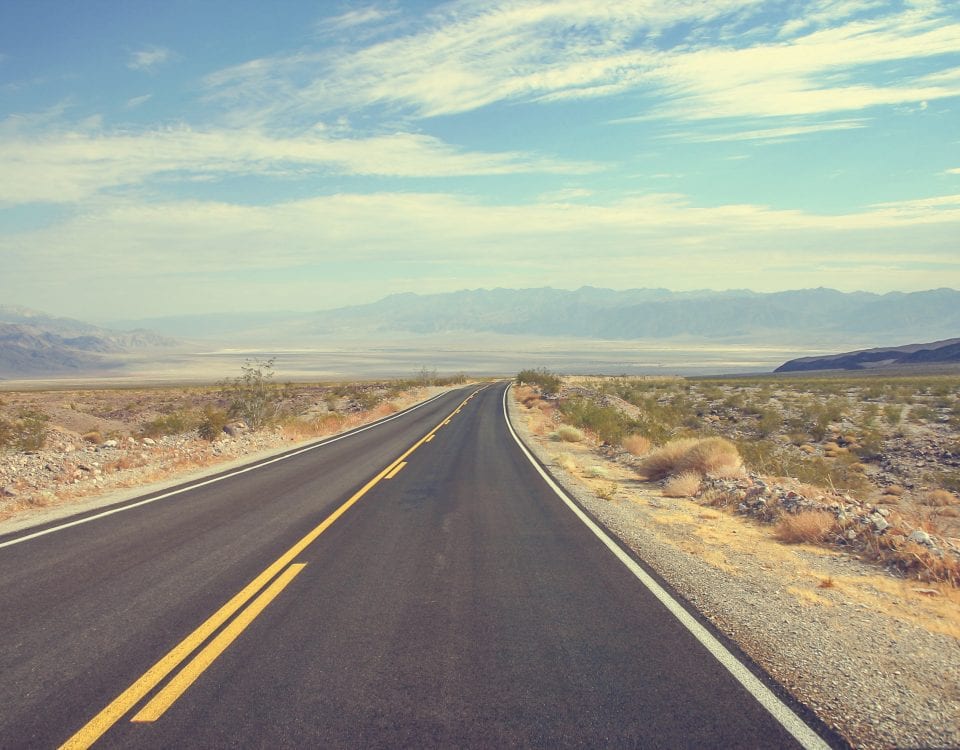
Day 41: Mark Twain and the Gateway to the West
April 29, 2021
Day 39: Racing Into Indiana
April 27, 2021Most recently updated on February 10, 2024
Originally posted on April 28, 2021
The Land of Lincoln is in our sights, but first we will travel through part of the midsection of Indiana.
From Indianapolis, we head in a southwesterly direction for 45 minutes before we hit the town of Martinsville, a community of nearly 12,000 known for its goldfish, hickory chairs and mineral water.
Martinsville was founded in 1822 with a post office opening in 1823.
In the 1890s, the Old Hickory Chair plant opened. The name was changed to the Old Hickory Furniture Company in 1921. The factory operated in town until it closed in 1978. The owners subsequently opened a new facility in Shelbyville, Indiana, in 1982.
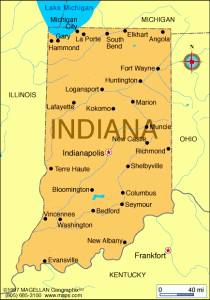
The furniture is valued as collectible items. A number of these chairs were sent to the Old Faithful Inn in Yellowstone National Park in 1904 and are still in use today. In 1989, Disney World in Florida ordered $1 million worth of chairs for its amusement park.
Martinsville is also known for its fish hatcheries. In 1899, Eugene Shireman turned swampland on his property into a fish raising business and opened the Glassyfork Fisheries with 200 fish. When the firm was sold to Ozark Fisheries in 1970, it was producing 40 million goldfish per year. Grassyfork is listed on the National Register of Historic Places. Ozark now specializes in six types of goldfish and two types of koi in 600 ponds.
Martinsville still has several large fisheries that sell their small aquatic products all over the world. A number of smaller fisheries also exist in town. No surprise it’s called the “Goldfish Capital of the World.”
From the late 1800s to the early 1970s, Martinsville was also known for its sanitarium spas. The first spa was built in 1888 by Sylvanus Barnard, who discovered artesian mineral water here while drilling for oil.
The city had 12 of these spas over the next 80 years, including two that served African-American customers. The spa services included mineral baths, Turkish baths, massages and physical therapy. All these establishments earned Martinsville a secondary nickname of “The City of Mineral Water.”
In the 1930s, the rise of antibiotics and other medicinal treatments began to slowly erode the spas’ business. The last spa was closed in 1971. In 2002, an aquifer known for its healing qualities was found to be contaminated with dry cleaning chemicals.
The industries here today include the Twigg Corporation, which produces jet aircraft engine components.
In October 2021, the city received a $20 million grant from the state to shore up some of its existing levees and build a new one. The levee upgrades are expected to reduce the risk of flooding here as well as spur economic development.
Martinsville is in the midst of revitalizing its downtown area with new restaurants and shops opening up. Among the new businesses are some older ones. They include the Martinsville Candy Kitchen, a family-owned, old fashioned candy store that has been open for a century now. There’s also the Hunter’s Honey Farm, which has been operating for more than 100 years and has 4,000 Christmas trees on its 65-acre property in addition to its honey-making business.
In addition, the city is home to the Art Sanctuary, which is located in an old church and houses several resident artist studio spaces.
Martinsville also has a piece of college basketball lore. Famed UCLA basketball coach John Wooden was born here and played on the high school team, which won the state championship in 1927.
—————————————
As we head out of town, we slide onto Interstate 69 for a half-hour jaunt south.
It’s here we park for a few moments at Bloomington, a community of 78,000 where life sciences and limestone are both big businesses.
The Miami and Delaware were among the tribes that initially lived here.
The town was established in 1818 by Southern settlers who named it after the “haven of blooms” they saw due to the area’s 45 inches of rain per year.
Bloomington sat on an established trade route early on. It also had an abundance of spring water as well as salt works that were active in the 1820s. An iron works also thrived.
A stagecoach line connected Bloomington to Indianapolis and Louisville before the railroad arrived in 1854. A foundry developed for cast iron fences, urns, benches and cannons. A furniture factory operated from 1868 to 1955.
The big industry here, however, has always been limestone.
The area is full of limestone quarries due to its terrain of sinks, fissures, ravines and underground streams. The material in this region is called Indiana limestone, although there is also some Bedford and Salem limestone.
The limestone is in an area known as the Stone Belt that is 10 miles wide and 35 miles long. Some of the limestone is 90 feet thick with some of the blocks weighing 20 tons.
The limestone is taken to mills where it is sawed, planed and shaped.
The first quarry was dug in 1827. In 1929, the region produced its peak of 12 million cubic feet of usable stone. Today, it produces more than 2 million cubic feet per year.
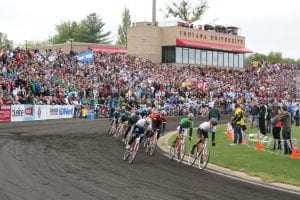
The Little 500 bicycle race at Indiana University. Photo by Visit Bloomington.
The limestone is used for buildings, bridges, courthouses and tunnels. The Indiana limestone was part of the construction of the Pentagon, the Empire State Building and Yankee Stadium.
The Bloomington area has suffered from some PCB pollution since the 1950s unrelated to the limestone industry. A Westinghouse Electric plant was identified as the source. An EPA cleanup at six sites began in 1984. Three sites are still being cleaned up.
The economy today is also driven by education, advanced manufacturing, technology and life sciences. In fact, the life sciences job market intensity is six times higher here than the national average.
Part of the reason is Indiana University, which educates more than 45,000 students and contains more than 200 research centers and institutes. One of those facilities is the Kinsey Institute, which research sexuality, gender and reproduction.
A former Indiana University president was in the news in spring 2021. That’s when city and university officials launched a campaign to rename Jordan Avenue. The street was named after David Starr Jordan, who was the college’s president from 1885 to 1891. Jordan was a proponent of eugenics, which is the practice of controlled selective breeding carried out by forced sterilization. University officials had already stripped Jordan’s name from a section of road as well as a hall, parking garage and river because he held “views that conflicted fundamentally with the university’s values.” In February 2022, the street was renamed in honor of jazz musician and music instructor David Baker.
Indiana University was also the setting for the 1979 movie, “Breaking Away,” about a small town boy obsessed with an Italian bicycle racing team.
The college now hosts the Little 500, the largest college bicycle race in the country. The race has been around since 1951 and is held in April.
Bloomington also has its musical side.
Singer John Mellencamp, known for such hits as “Jack and Diane,” “Hurts So Good” and “Small Town,” was born in nearby Seymour, Indiana, and now lives in Bloomington.
David Lee Roth, the lead singer for Van Halen in the 1980s, was born in Bloomington and spent much of his childhood here.
And to complete this musical trifecta, singer and songwriter Hoagy Carmichael was born right here in Bloomington.
———————————————–
Bloomington is also home to the Indiana Recovery Alliance.
The organization helps people with a wide variety of ailments and conditions. Their focus is on harm reduction.
They say their syringe reduction program is a “small part” of what they do, but Indiana has had a need for needle exchange services for the past decade.
The state developed a serious outbreak of HIV and hepatitis C in 2015 due to the use of opioid needles by addicts.
The town of Austin in southeast Indiana was one of the centers of that epidemic. The problem started there because of the use of Opana as a recreational drug. The U.S. Centers for Disease Control and Prevention (CDC) called Austin the center of the “largest drug-fueled HIV outbreak to hit rural America in recent times.”
The surge in HIV and hepatitis C cases ignited a debate in Indiana over needle exchange programs.
Mike Pence, who was Indiana’s governor at the time, at first declined to endorse the needle exchange programs, then reversed his stance.

The Indiana Recovery Alliance supports syringe exchange and other programs throughout the state. Photo by the Indiana Recovery Alliance.
A needle exchange program began in Austin in late 2015. Another campaign started in Allen County, which includes Fort Wayne, in November 2016. The town of Anderson, northeast of Indianapolis, began a program, cancelled it and then brought it back. Lawrence County ended its needle exchanges in 2017.
A report in 2018 concluded that needle exchange programs could have helped prevent the Indiana outbreaks.
Nationally, more than 40 states now permit syringe exchange programs. Indiana has 7 such programs statewide.
Opponents of the exchanges say they encourage drug us while supporters point to decades of research indicating the programs can reduce the spread of diseases.
——————————————
From Bloomington, we take Highway 46 in a northwesterly direction for our final stop in Indiana.
In a little more than an hour, we arrive at Terre Haute.
This community of nearly 60,000 people has quite a varied history from prisons to Socialists to harness racing.
This area along the Wabash River was initially inhabited by the Wea tribe. French explorers scouted the area in the 1700s and named it for the French words meaning “high land” because of how it sits above the river. These highlands were originally the border between Canada and the Louisiana Territory.
The first permanent European settlement was Fort Harrison, which was built in 1811. The village itself was laid out in 1816. The early economy relied on farming, milling and pork processing. The Wabash River as well as some canals connected Terre Haute to other centers.
Eventually, iron and steel mills as well as hominy plants, breweries and distilleries were established. After the railroads arrived in 1852, coal operations as well as grain production for alcohol and food items thrived.
The city built numerous theaters and opera houses, which made it a regular stop on the vaudeville circuit. The Four Cornered Race Track for harness horse racing opened in 1886. It’s now the city’s Memorial Stadium, a 12,000-seat facility used primarily for college sporting events.
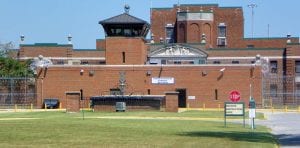
The Federal Correctional Complex in Terre Haute, Indiana, was where Oklahoma City bomber Timothy McVeigh was executed. Photo by BOP.
In 1940, a new prison opened. The Federal Correctional Complex with 1,200 inmates housed in two complexes is still here. The prison was the place where Timothy McVeigh was executed in 2001 for the 1995 Oklahoma City bombing, the memorial that we visited on Day 9.
During World War Two, Terre Haute had three ammunition plants. There were plans for a time in 1944 for one of the factories to produce anthrax bombs to provide to Great Britain, but those chemical weapons were never manufactured.
After the war, the city’s economy remained reliant on manufacturers. One of them was Quaker Maid, whose Terre Haute’s factory was at one time the nation’s largest food processing facility under one roof. It employed 1,200 people at its peak. The factory opened in 1930 and closed in 1979.
A downtown revitalization has helped the economy in recent years. It may soon get a lift from the local Sony DADC plant, where compact discs used to be manufactured. The factory, which laid off 100 workers in 2022, is revamping its facilities so it can start producing medical devices.
Terre Haute is also home to Indiana State University, an 8,000-student campus located downtown.
The LaVern Gibson Championship Cross Country Course is here, too. The 250-acre site has hosted 15 national championship races. The land was previously used as a coal mine and landfill. The acreage was endowed by LaVern Gibson, a local business owner whose was inspired by watching his grandson run cross country. The course was dedicated in 1997. The race course has prompted Terre Haute to call itself “Cross County Town USA.”
The city is also the site of the Eugene V. Debs Museum. The complex is in the former home of the Socialist labor organizer and presidential candidate. Debs was born in Terre Haute in 1855. Among his labor activism was his stint as the president of the American Railway Union. He announced his conversion to socialism in 1897 and helped form the Socialist Party of America. Debs ran for president on the Socialist ticket five times between 1900 and 1920.
Another native son to Terre Haute is former Major League Baseball pitcher Tommy John, whose name is attached to the common elbow ligament surgery. John was born here and attended Gerstmeyer High School as well as Indiana State.
Entering Illinois
Out of Terre Haute, we take Interstate 70 west.
Within minutes, we cross the state line into Illinois and, in doing so, re-enter the Central Time Zone after 20 days in the Eastern Time Zone.
Illinois is the 6th most populous state in the country with more than 12 million people. It’s the most populated of the Midwest states.
A big chunk of the state’s citizenry lives in Chicago, which with its 2.6 million residents is the third most populous city in the country.
Illinois is 24th in size among states with its 55,000 square miles.
The Prairie State, as it’s called, is part of North America’s tall grass prairie, which is one of the most endangered ecosystems on Earth. In some areas, 99 percent of prairie lands have been destroyed.

Illinois is considered to be a microcosm of the United States with industrial cities such as Chicago in its northern sector, rich agricultural land in its center and natural resources such as coal and lumber in its southern regions.
Illinois, in fact, has the largest recoverable bituminous coal reserve of any state with nearly 1.2 billion tons. It also is the top soybean producing state. Illinois is also second in corn processing as well as fourth in pork production.
The Mississippi and Ohio rivers form part of its boundaries as does the Wabash River.
The French were the first European visitors, congregating along the Mississippi River in the late 1600s. In the 1780s, other settlers began arriving via the river.
The Erie Canal fueled growth in the 1830s. Then, John Deere’s steel plow helped turned Illinois’ land into rich, agricultural soil. The Deere headquarters is still in Moline, Illinois.
The state strengthened as a transportation hub when the railroads arrived. At one point, Illinois had 12,000 miles of rail lines. Coal mining and manufacturing were big industries during World War Two.
We’ll be cutting across the center of the Prairie State as we finish out our travels on Day 40.
—————————————-
About a half-hour after crossing into Illinois, we hit the town of Casey.
We’re stopping by this community of 2,300 for one reason.
And it’s not because it was settled in 1834 after the National Trail was built.
It’s also not because oil drilling began in Casey in 1904 and there were 2,000 wells by 1907 that produced 24 million barrels of oil that year, prompting John D. Rockefeller to buy an old field here in 1910.
We’re here because the folks in Casey, Illinois, know how to go big.
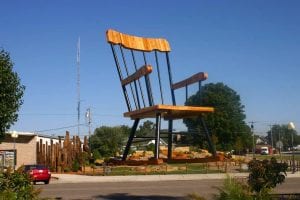
This big chair is one of 14 replicas in Casey, Illinois, that is in the Guinness Book of World Records. Photo by My Modern Met.
The town is known for constructing large replicas of household items. In fact, 14 of these replicas around the community are in the Guinness Book of World Records.
They include the world’s largest golf tee at 30 feet in length. The tee, made from yellow pine wood, hangs in a city park.
There’s also the planet’s largest mail box at 32 feet in height.
The world’s largest pitch fork is here, all 60 feet and 1,940 pounds.
One of the town favorites is the record wind chime. It’s 55 feet tall with five chimes.
Not too far away is the world’s biggest rocking chair made of recycled material. It’s 32 feet high and weighs 46,000 pounds.
Perhaps the most clever is the giant yardstick that is 36 feet, instead of 36 inches, in length.
Other record items include a 4-foot-high wooden shoe located in the Casey Candy Depot as well as the 32-foot-high pencil.
The idea for the record replicas came from Jim Bolin, who saw it as a way to help the local economy. He created the first one, the wind chime, in 2011.
You have to love the town’s motto, too. It’s “Big Things in a Small Town.”
——————————————————
Our final stop for today involves a 2-hour drive from Casey to a town closely connected to one of the nation’s most famous presidents.
To get there, you take Interstate 70 west for a half-hour and then head northwest on a series of two-lane highways.
You finally reach Springfield, the state capital of Illinois that’s best known as the home of President Abraham Lincoln.
There’s plenty to see here honoring the nation’s 16th president, but this community of 112,000 also has some historic firsts in the food industry as well as a dubious honor involving a famous ill-fated family journey.
This region of central Illinois was first settled by Europeans in the 1810s. It was named after nearby Spring Creek. The town became the state capital in 1837 and was incorporated as a city in 1840.
The Potawotami Death Trail came through in 1838 when 800 members of the Potawotami tribe were forced to relocate from Indiana to Kansas of a federal government resettlement program. During the 10-week, 660-mile, 41 of the tribe members, mostly children, died.
Lincoln was born in Kentucky and came to Springfield at the age of 28 in 1837. He worked as a lawyer and a politician. He lived here until he moved to Washington, D.C., in 1861 after being elected president.
Lincoln gave a famous farewell speech when he departed for the nation’s capital at the Great Western Depot, a national historic site here no longer used for transportation.
After he was assassinated, Lincoln’s body was returned to Springfield, where he was laid to rest.

One of the exhibits at the Abraham Lincoln Presidential Library & Museum in Springfield, Illinois. Photo by No Home Just Roam.
During the Civil War, Union soldiers trained in Springfield, for a time under the guidance of General Ulysses S. Grant. The city became a major railroad hub after the war. Coal mining was important in the early 1900s.
The economy today is centered on government jobs. Healthcare, insurance and transportation are also important as is agriculture. Springfield remains a farming center with corn and soybeans being major products.
Tourism is also a vital component, driven mostly by the array of historic places connected to Lincoln.
There’s the Abraham Lincoln Presidential Library & Museum. It took eight years to build and opened in 2005. The 200,000-square-foot facility contains a library, archive and museum in an “experience” atmosphere.
There’s also the Lincoln Home National Historic Site, which spotlights the home where Lincoln lived in Springfield. It’s contained in a 4-block park on 12 acres with a visitors’ center. This is the only home Lincoln ever owned. He bought in 1844 with his new wife, Mary Todd. All four of the couple’s sons were born here. One son, Edward, died here. Robert Todd Lincoln donated the home to the state in 1887 under the condition it be kept in good shape. It was established as a national historic site in 1972.
The Lincoln-Herndon Law office is the place where the future president and his law partner, Stephen Logan, set up shop in 1843. That partnership broke up in 1844. Lincoln then teamed up with attorney William Herndon. They worked in that office until 1852, when they moved to a new location.
The Lincoln Tomb is in Oak Ridge Cemetery on the outskirts of town. Mary Todd Lincoln as well as three of the couple’s four sons are also buried here. The tomb consists of a single-story base with a 117-foot obelisk. It was dedicated in 1874 and designated as a historic landmark in 1960.
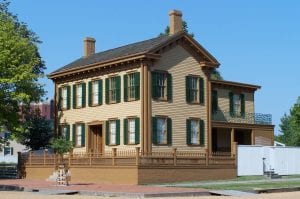
This house in Springfield, Illinois, was the only home Abraham Lincoln ever owned. Photo by ThoughtCo.
Springfield also is home to the Old State Capitol building. It was the statehouse from 1839 to 1876. Lincoln delivered his famous “House Divided” speech here in 1858. It was also Lincoln’s presidential campaign headquarters in 1860. The building was designated as a national historic landmark in 1961. Barack Obama made his presidential campaign announcement speech on the Capitol steps in February 2007. He also used the building to announce Joe Biden as his running mate in August 2008.
In addition, the city is the site of the Dana-Thomas House, one of architect Frank Lloyd Wright’s early “prairie homes” and one of the best preserved. The 3-story, 12,000-square-foot home has 35 rooms. It sits on 3 acres. It was designed in 1902 for Susan Lawrence Dana.
Four other historical events happened in Springfield. Two involve food and the other two did not have happy endings.
In April 1846, the 90 members of the Donner Party began their journey from downtown Springfield. Eventually, they got trapped in heavy snow in the Sierra Nevada and reportedly had to resort to cannibalism. Only 45 of the original team members made it to California.
In 1908, the city where Lincoln lived was the scene of a major race riot.
Two incidents seemed to ignite the melee. One was the dropping of charges against a Black man accused of raping a white woman. The second was the conviction and hanging of a Black man convicted in the murder of a white man.
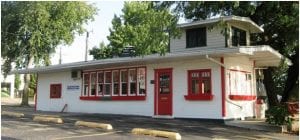
The Maid-Rite Sandwich Shop in Springfield, Illinois, claims to have the nation’s first drive-up service window. Photo by SangamonLink.
During the riot, groups of white workers attacked Black neighborhoods. Two Black men were lynched and six Black men were shot to death. Five white men were also killed. The state militia was sent in to quell the disturbance.
More than 100 white men were arrested, but only one was charged with a riot-related charge. Over the ensuing months, 2,000 Black residents left town. The riots led to the formation of the NAACP. A bronze sculpture was dedicated in a city park in 2009 in remembrance of the riot.
On a lighter note, the Maid-Rite Sandwich Shop still has what its owners say was the nation’s first drive-through service window. The window opened in 1928. It was originally a walk-up window that served sandwiches and root beer before being converted to a drive-up slot. Part of the success of the shop has been that is it is near Springfield High School.
Finally, local residents say the corn dog was invented here under the name “cozy dog.” It was served at the Cozy Dog Drive In, starting in 1946. The Cozy Dog moved into its current location in 1996, next door to the original building south of downtown.
Since we’re comfortable, we’ll call a halt to our travels for today.
Tomorrow, we head toward Missouri with stops at a town known for bird houses, the place a famous American author called home and the city known as the gateway to the western United States.

